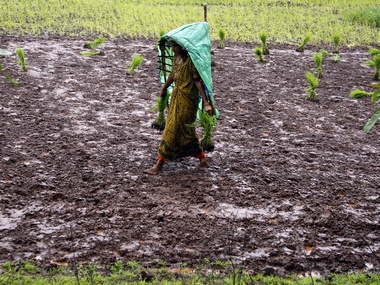Farmers get a minimum support price for their agricultural produce. Correct?
Wrong, according to the RBI. In a recent discussion on agricultural productivity, the central bank slammed the comfortable idea that most farmers can sell their crops at government-supported prices, pointing out that most of them did not have access to government-owned granaries or sales points in the first place.
Farmers have not really benefited from the government as the public procurement system has been limited to a few states, the RBI added. Moreover, whatever the government granaries buy tends to pile up as inventories since disbursals through the public distribution system are also low.
[caption id=“attachment_77579” align=“alignleft” width=“380” caption=“small or marginal farmers - the key target customers - don’t even claim a good share of rural-directed funds. Reuters”]
 [/caption]
[/caption]
Clearly, agriculture has been plagued by several problems. K C Chakrabarty, RBI deputy governor, says the sector suffers from four major problems: declining yields, low productivity, regional disparities and inappropriate food stock management. Consider the data supporting his arguments.
After adopting high-quality seeds and fertilisers in the mid-1960s, production of rice and wheat went up 28 percent and 23.6 percent, respectively, in 1967-68. Such growth rates have rarely been seen in India. In the two years to 1970, production of rice, wheat and foodgrains grew at 21.9 percent, 10.3 percent and 10.9 percent, respectively. The yield of these crops also improved between 8 percent and 11 percent.
Over the next two decades until 1990, rice, wheat and foodgrains production expanded by 5.1 percent, 4 percent and 3.3 percent, respectively, against population growth of 2.2 percent. During that period, India was placed comfortably in terms of sufficiency in foodgrain production.
However, from 1990 to 2010, the growth rate of production of rice, wheat and food grains declined to 2.6 percent, 1.4 percent and 1.6 percent, respectively. Average growth in the production of foodgrains (1.6 percent) fell below the average growth of population of 1.9 percent. Consequently, the daily per person availability of food grains came down from 510.1 grams in 1991 to 444 grams in 2009.
Even against global standards, India looks unimpressive. Estimates of rice yields at the end of April 2011 in India were 3.2 tonnes per hectare as against 7.5 tonnes per hectare in the United States, 6.7 tonnes per hectare in China and an average of 4.3 tonnes per hectare for the world. Even the best state in India - Punjab, with the highest yield in rice produced 3.8 tonnes per hectare - is no match against the world average of 4.3 tonnes per hectare.
Currently, there are strong possibilities of shortages in key food items like milk and eggs. The National Dairy Development Board says India will need 180 million tonnes of milk by 2021-22. This means India must add 5 mt of milk to its capacity every year to attain self sufficiency then. This is double the 2.5 mt it adds now every year. National Institute of Nutrition recommends 11 kg of meat and 180 eggs for each individual in a year. India can manage 1.6 kg of meat and 42 eggs.
More than 95,000 tonnes of foodgrains were spoilt in 2005-06. While the quantity has fallen since then, it is ironic that around 6,500 tonnes of grains were spoilt even in the past year - April to March 2011. The government has now allocated Rs 2,000 crore to Nabard, the apex agricultural bank, and directed it to build storage facilities immediately. So, why has Indian agriculture languished over the past two decades? Quite a few reasons are responsible for that, ranging from a lack of irrigation facilities, quality seeds and fertilisers to fragmented land holdings.
So, instead of trying to push for a Food Security Bill, the government would do better to introduce agricultural reforms, especially for enhancing disbursals of agricultural credit and micro insurance to farmers. LIC already hopes to bring in one crore policy holders under its microinsurance scheme by the end of the financial year ending March 2012. That number stood at around 30 lakh last year.
Agricultural credit disbursals have generally been flawed, with as much as 30 percent of rural credit disbursed in non-farming seasons. That means the money does not go into improving farming techniques. Moreover, small or marginal farmers - the key target customers - don’t even claim a good share of rural-directed funds. Government data shows that even the number of self-help groups, created to improve access to credit, linked to financial institutions dropped to 12 lakh this year from 16 lakh in 2009.
Of course, adequate and properly directed disbursal of credit is not enough to improve the agrarian economy. Finance is only the first step to introducing long-term investment in farming and allied activities. That realisation seems to have sunk in because it seems the government is now planning a separate agriculture budget. Charandas Mahant, Union agriculture minister of state, has said: “The Union agriculture Budget will include four parts: allocation for rabi and kharif crop promotion schemes, allocation for fertilisers and administrative mechanism, allocation for research and development and funds for horticulture.”
The government has revised its GDP targets downward for this year - April to March 2012 - bringing it down to 8 percent. But agricultural growth is still estimated at a relatively high 3.5 percent. Whether that optimism is justified remains to be seen.
)